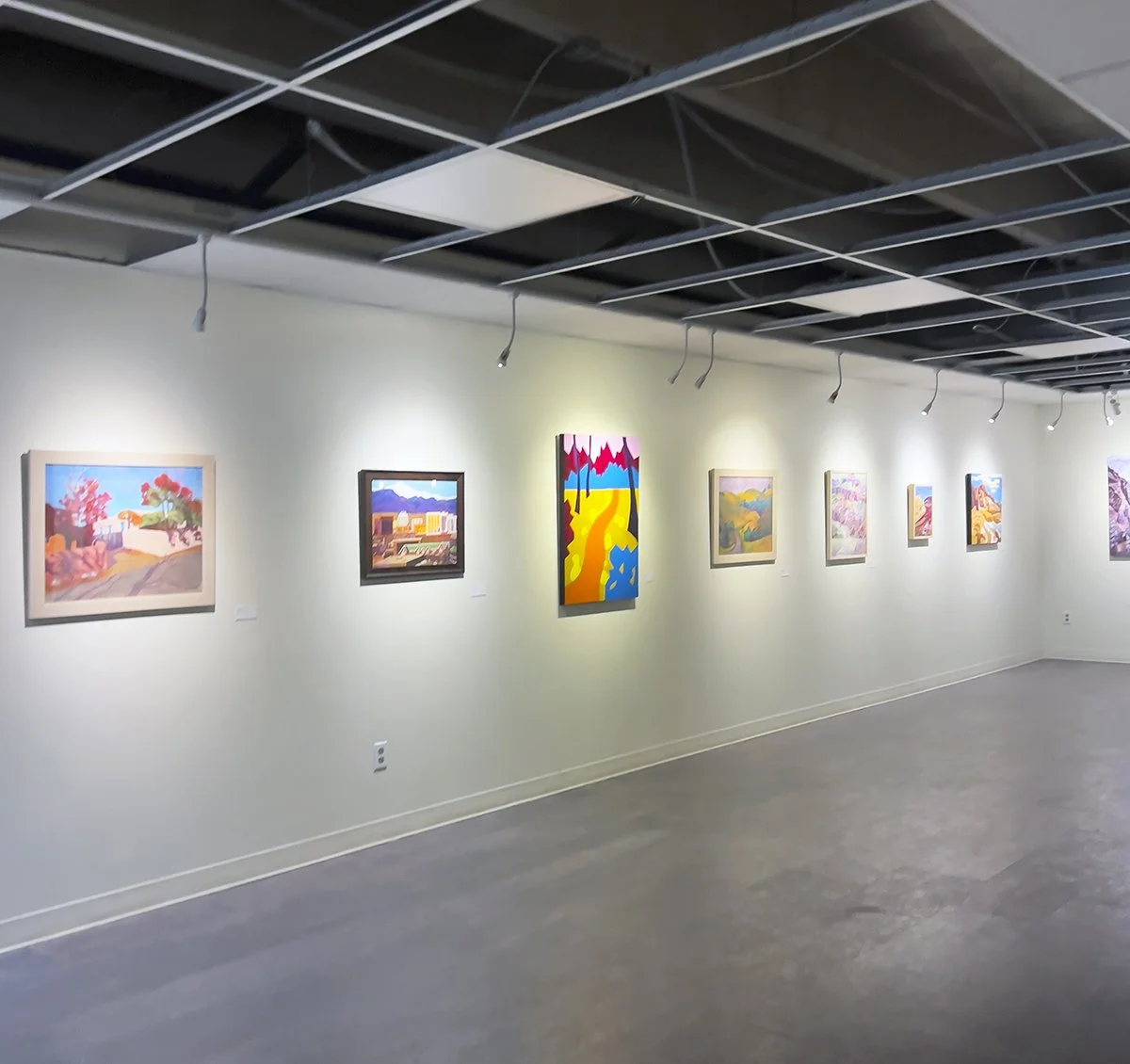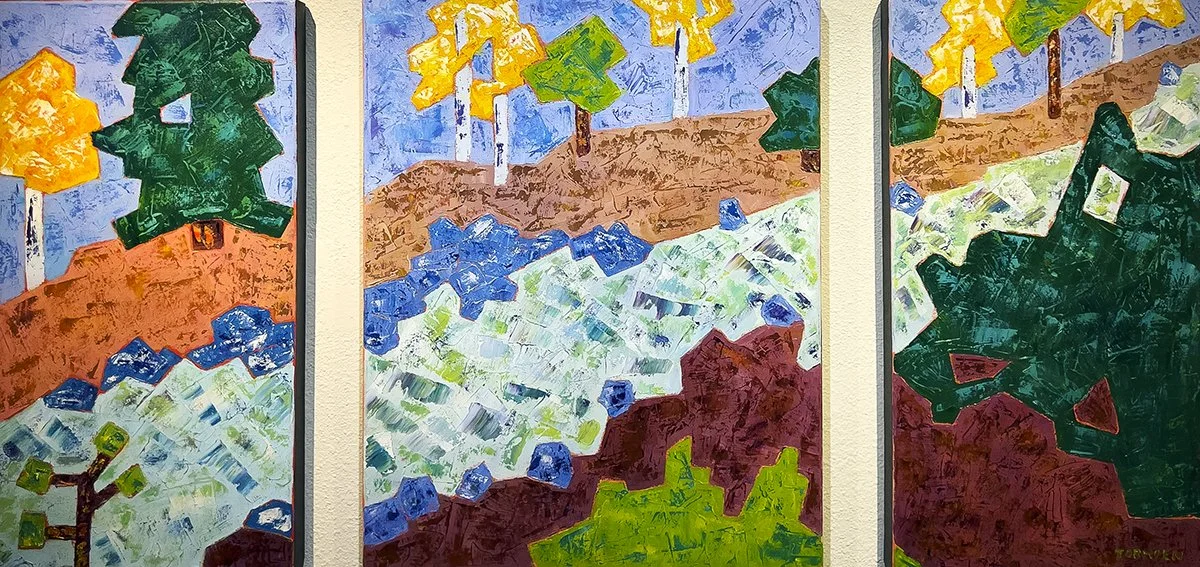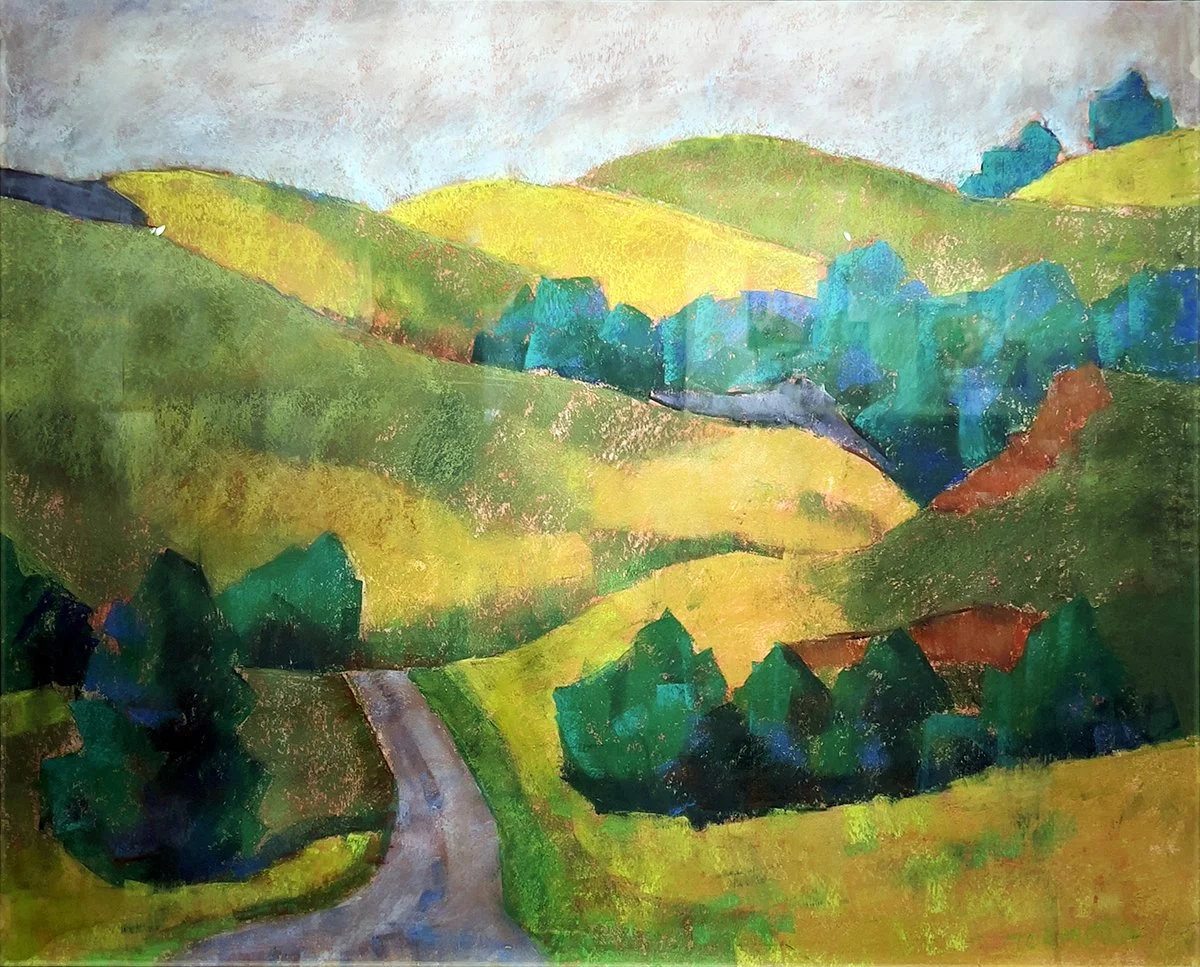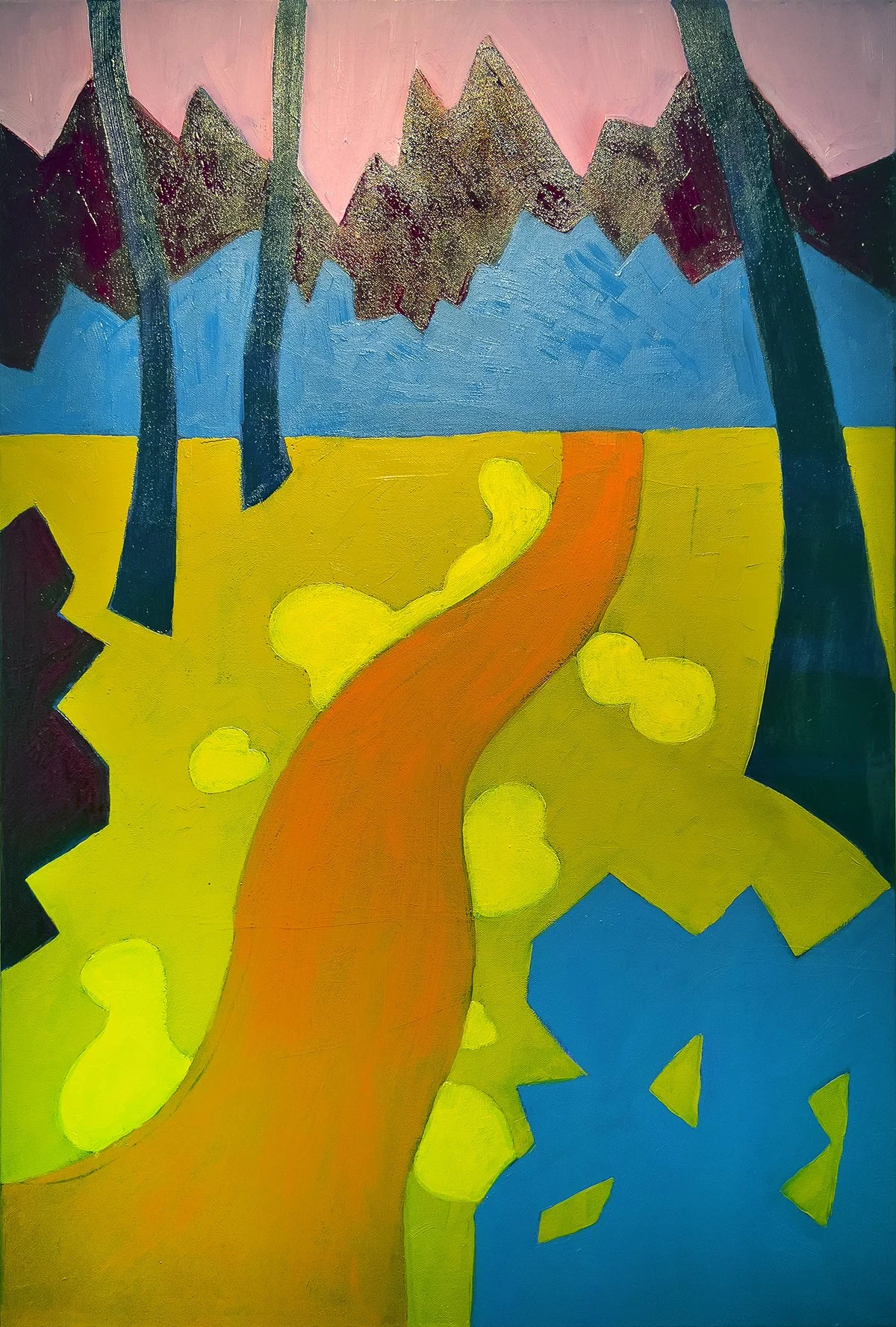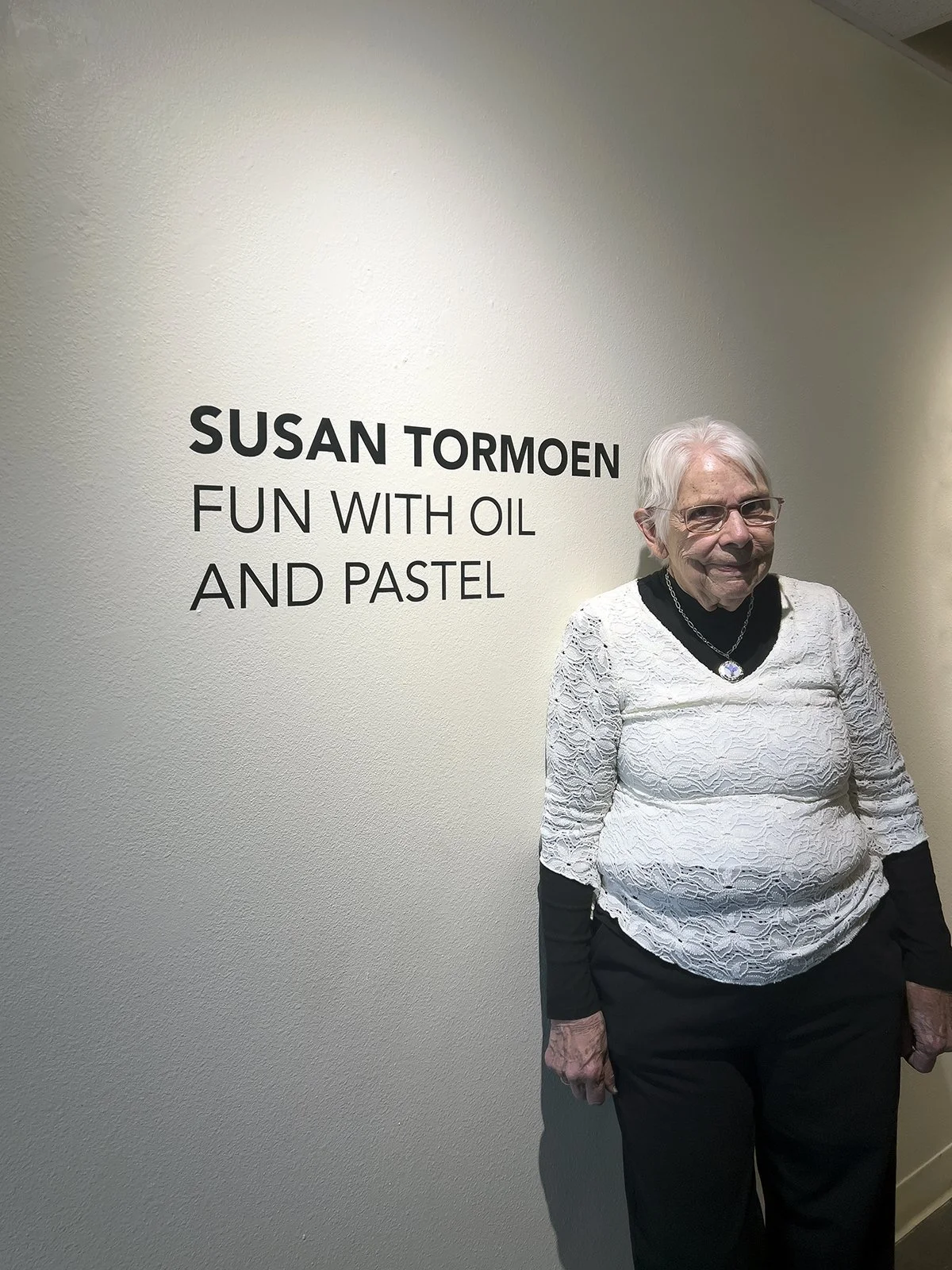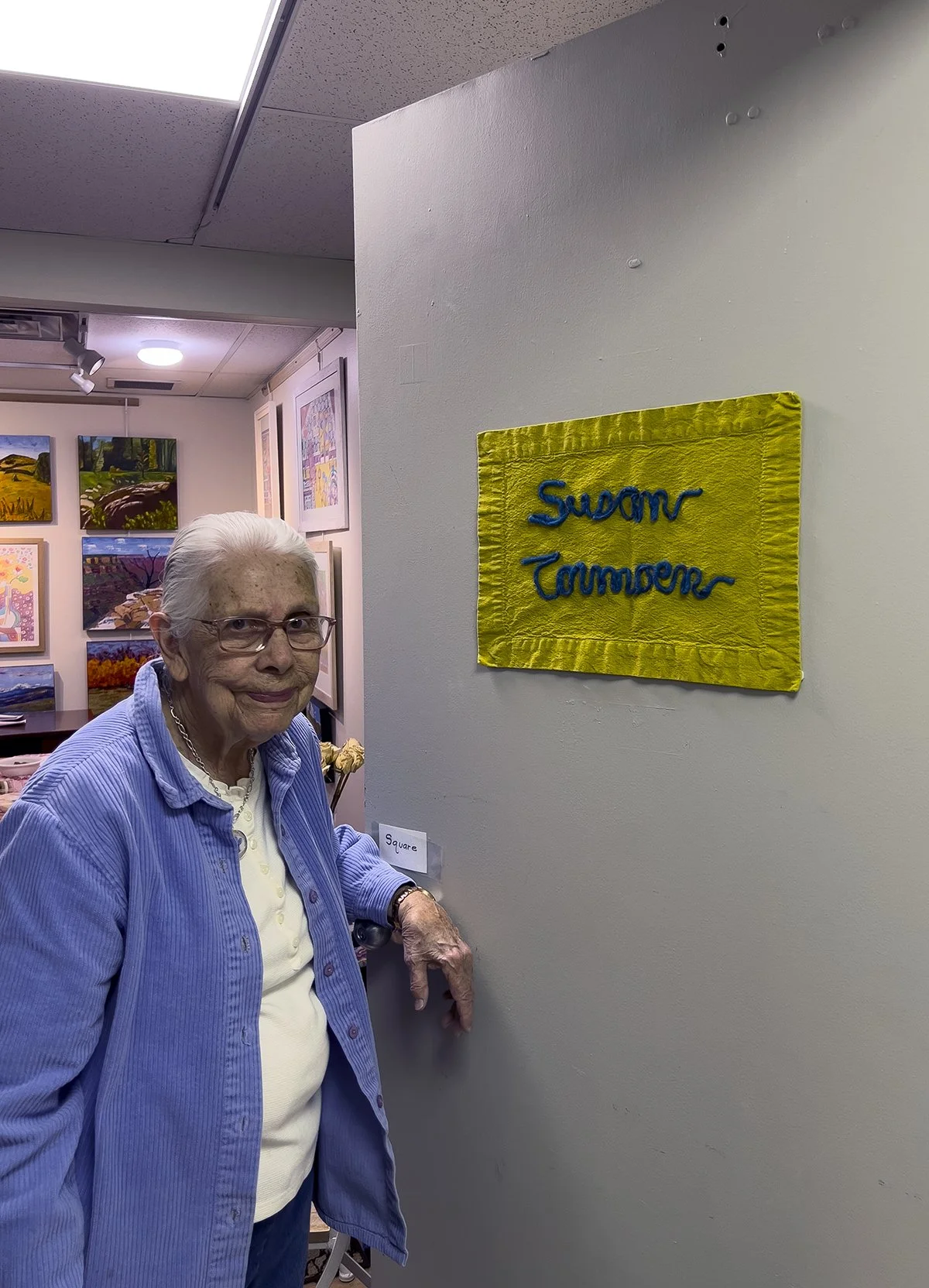Fun with Oil and Pastel
Susan Tormoen: Fun with Oil and Pastel
Cottonwood Center for the Arts
427 E. Colorado Avenue, Colorado Springs, CO 80903
May 2–31, 2025
Admission: free
Review by José Antonio Arellano
Susan Tormoen’s abstracted landscapes raise questions concerning relevance and necessity: of contemporary landscapes in particular, of a sustained painting practice more generally, and of this very review. Why should you bother reading these words when you could just look at the following pictures? And why, if breathtaking vistas are so readily available and framed by Coloradan windows, are Tormoen’s paintings themselves necessary?
An installation view of Susan Tormoen’s exhibition Fun with Oil and Pastel at the Cottonwood Center for the Arts. Image by José Antonio Arellano.
Her latest exhibition at the Cottonwood Center for the Arts in Colorado Springs offers answers. Aptly titled Fun with Oil and Pastel, it showcases the sense of play that permeates her practice, with over half a dozen styles visible in the twenty or so landscapes on display.
Susan Tormoen, Black coming through with Aspen, oil on canvas. Image by José Antonio Arellano.
“Style,” as the art philosopher Arthur Danto argues, “is the man”—an unfortunately gendered definition that describes artistic “style” as akin to the idiosyncratic way an individual artist expresses herself. [1] Through all of the experimentation with pastels and oils, painting knives and brushes, it remains possible to identify “a Tormoen” from across the room.
Susan Tormoen, River in Three Panels, oil on canvas triptych. Image by José Antonio Arellano.
Some of her landscapes feature bold palette knife strokes of brightly colored oil paint. The visible, jagged strokes and the lack of optical color blending produce a more direct visual confrontation than the pointillism of, say, Paul Signac and Georges Seurat. The faceted surfaces evoke Paul Cézanne’s geometric experimentation, but in Tormoen’s hands, these allusions to the nineteenth century take on a different historical significance in 2025.
Susan Tormoen, Red Mountain with Patch of Trees, oil on canvas. Image by José Antonio Arellano.
The story of art used to be narrated as one of progression, in which artists steadily improved their ability to re-present the world. Danto describes the goal of this developmental story as one of “optical duplication,” which tries to replace the need for artistic “inference” with what he calls “direct perception.” [2] This story implied that empirical progress was possible. Combined with the narrative of science, we could bring the world into our reason by representing and knowing it.
Susan Tormoen, Rolling Hills with Road, pastel on paper. Image by José Antonio Arellano.
Describing this story in such a reductive manner exposes its deficiencies. When Tormoen studied philosophy in the mid-twentieth century, she would have encountered the history of thought that identifies an epistemic gulf that separates us from the world. The tools we use to represent the world will always get in the way. Our very senses are not reliable, as we cannot know a world outside of the concepts we use to understand it.
Still, so the story goes, with the advent and availability of photography, and then “moving pictures,” painters were free to explore the conditions of painting itself. [3] Art came to be “construed as expression” instead of “representation,” the self-expression of, say, the inner self, rather than the representation of nature; the expression of one’s style rather than an adherence to established norms. [4]
Susan Tormoen, Red River II, oil on canvas. Image by José Antonio Arellano.
Today, art history is about individual selves (and their groups, which amount to a self writ large) and their styles. Art history is “relativized” such that “The history of art is just the lives of the artists, one after another.” [5] All we have are individuals/groups expressing their styles, each awaiting the chance to be noticed.
There is something simultaneously liberating about this pluralism and profoundly alienating, if not mistaken entirely. Such an account of art corresponds to a view of society composed of individuals and groups that exist in a marketplace of styles. You have your style; I have my own. You either like mine or you don’t. Data-driven targeted advertising coalesces groups based on demographic profiles and content interests. Fandoms await familiar content; algorithms tabulate likes.
Susan Tormoen, The Canyon, pastel on paper. Image by José Antonio Arellano.
I want to suggest that Tormoen’s paintings invite us to think differently about style as it emerges in history. Instead of art history narrated as one style after the other, a competing account remains available that attempts to articulate the meaning of form, how art embodies meaning, and how it creates a public bound by normative aesthetic judgments about what works of art mean. This is not the type of meaning wherein x = y in the algorithmic noise we see stochastically generated by ChatGPT. It is the type of account that tries, as best as it can, to come to terms with the meaning of paintings such as Tormoen’s.
Susan Tormoen, Few Trees, oil on canvas. Image by José Antonio Arellano.
Take, for example, Tormoen’s paintings composed of different-sized canvases arranged together to depict a landscape. When she showed me these works in progress, she hesitantly asked, “What do you think?,” but I got the sense that the question was not about whether I liked them or not. She was going to experiment regardless of my opinion.
By piecing together the canvases, Tormoen emphasizes the framing effect of her art that does not simply want the beholder to see through the painting to the landscape it captures. She asks us to take notice of the painting itself, the painting as painting. The expansiveness of the referenced landscape and the impossibility of a painting to capture it suggest that a painting is finite in a way that “nature” can never be. A painting is thereby capable of achieving what nature, as such, cannot.
Susan Tormoen, Utah Shown Here, oil on canvas. Image by José Antonio Arellano.
There is a normativity at the heart of these works of art, a normativity that does not obtain in experiences of sunsets and aspen groves. A painting embodies a meaningful account of itself that we are called upon to confront.
Although Tormoen tends to paint from photographs, often turning to the meticulously cataloged boxes of her snapshots, the aim of her work is aesthetic impact, not mimetic verisimilitude.
Susan Tormoen, Coloration, oil on canvas. Image by José Antonio Arellano.
The colors she uses are not found in the landscapes her paintings reference. She is trying to discover something that market deliberation or a shared sense of taste does not begin to touch. In an interview with the local newspaper, Tormoen asserts:
I do different things all the time. That makes it fun… Those abstract colors won’t go anywhere even though I think they’re nice because they’re interesting. But people won’t have seen anything like that in anyone else’s house and won’t buy them. I don’t really care. I like to show them anyway. I like to do them anyway. [6]
Susan Tormoen, Aspen Reflected, oil on canvas. Image by José Antonio Arellano.
She is not referring to the deliberation concerning the size of the canvas (smaller canvases tend to sell), color (some colors more easily anchor a living room’s décor), or subject matter (what will more readily appeal to a market). She refers to the sense of play that calls upon her to get in touch with something else for which we do not have a word.
Susan Tormoen at her Fun with Oil and Pastel exhibition. Image by José Antonio Arellano.
Tormoen, who will turn 90 this year, has been painting for decades. She is a mother and grandmother; she studied philosophy during the mid-twentieth century. She was diagnosed with schizophrenia at the age of thirty. [7] I want you to know her story because her remarkable life matters deeply, but I focus on her paintings because they can convey what a biography cannot.
Susan Tormoen, Our City, pastel on paper. Image by José Antonio Arellano.
A painting such as Our City is an invitation to see the world as Tormoen sees it, but it is also an invitation to consider the implied “us” of the title—to consider a world in which real estate development and tourism steadily commodifies “the view” while the possibility of a flourishing life steadily dwindles for most. What, exactly, makes up a city? And what, exactly, makes it “ours”? Who makes up the implied “us”?
Susan Tormoen at her studio in the Cottonwood Center for the Arts. Image by José Antonio Arellano.
Susan, known by her friends as Sue, shows up to paint at her studio in the Cottonwood Center for the Arts almost every day. Call this consistency an act of love or duty, or describe it via another concept you cherish, even as you cannot define it concretely. There is a nobility to this life that we should honor by attending to its meaningful work and by protecting the studio spaces that make it possible.
José Antonio Arellano (he/him) is an Associate Professor of English and fine arts at the United States Air Force Academy. He holds a Ph.D. in English language and literature from the University of Chicago. He is currently working on two manuscripts titled Race Class: Reading Mexican American Literature in the Era of Neoliberalism, 1981-1984 and Life in Search of Form: 20th Century Mexican American Literature and the Problem of Art.
[1] Arthur C. Danto, “Metaphor, Expression, and Style,” The Transfiguration of the Commonplace: A Philosophy of Art (Cambridge, MA: Harvard University Press, 1981), 204.
[2] Arthur C. Danto, “The End of Art,” The Philosophical Disenfranchisement of Art (New York: Columbia University Press, 1986), 86, 91.
[3] The availability of photography added pressure to landscape artists, as John House argues: “The landscape painter was expected to have special insight into ‘nature,’ particularly after the invention of photography, which superseded the purely reproductive function of landscape painting.” Photography also created a perceived need “to justify [landscape painting] as fine art.” John House, “Framing the Landscape,” in Critical Readings in Impressionism and Post-Impressionism: An Anthology, ed. Mary Tompkins Lewis (Berkeley: University of California Press, 2007), 81.
[4] Ibid., 104.
[5] Ibid.
[6] Jennifer Mulson “Schizophrenia Doesn’t Stop Colorado Springs Painter.” The Gazette, 10 May 2023, https://gazette.com/arts-entertainment/schizophrenia-doesnt-stop-colorado-springs-painter/article_0aad9ded-103b-4e30-bc5b-c22865339ba9.html.
[7] See Jon Huang’s “Brushstrokes of Resilience,” BEACON Senior News – Colorado Springs, 25 Feb. 2025, https://coloradosprings.beaconseniornews.com/2025/02/25/523823/brushstrokes-of-resilience.



